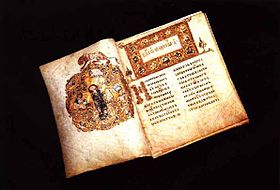TheOstromir Gospels(Russian:Остромирово Евангелие) is the oldest dated book ofKievan Rus'.Archeologists have dated theNovgorod Codex,a wax writing tablet with excerpts from the Psalms, discovered in 2000, to an earlier time range, but unlike the Ostromir Gospels, it does not contain an explicit date. It is currently held in theNational Library of Russia.[1]

The Ostromir Gospels was created in 1056 or 1057 (the year 6564 in the Byzantine calendar) by thedeaconGregory for his patronOstromir,theposadnikofNovgorod,probably as a gift for a monastery.
Description
editThe book is anilluminated manuscriptGospel Booklectionarycontaining only feast-day and Sunday readings. It is written in a largeuncialhand in two columns on 294 parchment sheets of the size 20 x 24 cm. Each page contains eighteen lines. The book is concluded by the scribe's notice about the circumstances of its creation.
Three full pageevangelist portraitssurvive, by two different artists, and many pages have decorative elements. The close resemblance between this and the equivalent pages in theMstislav Lectionarysuggests they are both based on a common prototype, now lost. The two artists who produced the evangelist portraits were both heavily influenced by Byzantine models, but the style of the portraits of Saints Mark and Luke seems to derive from Byzantine enamelled plaques rather than manuscripts.
More early Russian manuscripts have survived from Novgorod, which was never occupied by theMongols,than any other centre.[2]Like other medieval Russian manuscripts, the Ostromir Gospels is written in a peculiar local version ofChurch Slavonic.[3]For example, the word "водоу" ('water') is found rather than the correct Old Slavonic accusative form "водж", and the word "дрѫже" ('friend') is found rather than "дроуже" in the vocative form.[3]
Later history
editIt is thought that the book was taken from one of Novgorod's monasteries to the personal collection of the Russian tsars in theMoscow Kremlin,where it was first registered in 1701.Peter the Greatordered that it be taken toSt. Petersburg,where there was no mention of it until 1805, when it was discovered in the dressing room of the lateCatherine the Great.
The Gospels were deposited in theImperial Public LibraryinSt Petersburg,where it remains.Alexander Vostokovwas the first to study it in depth, demonstrating that theChurch Slavonicof the manuscript reflects theEast Slaviclinguistic background of the scribe. The first facsimile edition was published under Vostokov's supervision in 1843.
In 1932, the gem-studded book-cover induced a plumber to break into a case, remove and steal the binding, and hide the parchments behind a bookcase. Although the book was quickly recovered, no replacement binding has been provided to date.
See also
edit- Codex Zographensis(late 10th century or early 11th century)
- Novgorod Codex(first quarter of the 11th century)
- Svyatoslav's Miscellanies(1073, 1076)
- Archangel Gospel(1092)
- Mariinsky Gospel(11th century)
- Mstislav Gospel(1117)
- Yuriev Gospel(1119)
- Halych Gospel(1144)
- Dobrila Gospel(1164)
- Pantaleon Gospel(12th century)
- Eusebius Gospel(1282)
- Chelm Gospel(13th century)
References
edit- ^Stam, David H. (November 2001).International Dictionary of Library Histories.Routledge. p. 561.ISBN978-1-136-77785-1.
- ^Popova, Olga,Russian Illuminated Manuscripts,Thames & Hudson, London (or Braziller NY), 1984, nos 1-5, & pp 5-9
- ^abВинокур, Григорий Осипович (2 April 1971).The Russian Language: A Brief History.Cambridge University Press. p. 43.ISBN978-0-521-07944-0.
Further reading
edit- Evans, Helen C.& Wixom, William D.,The glory of Byzantium: art and culture of the Middle Byzantine era, A.D. 843-1261,no. 198, 1997, The Metropolitan Museum of Art, New York,ISBN9780810965072;full text available online from The Metropolitan Museum of Art Libraries